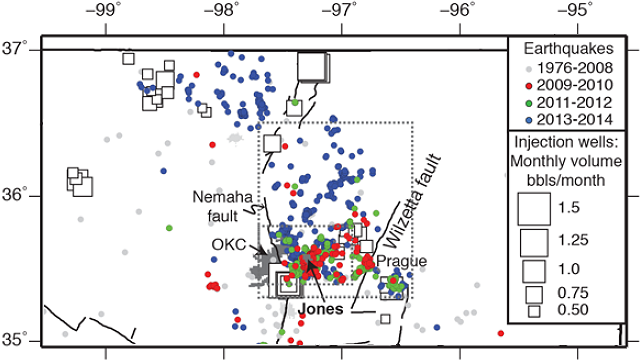
In today’s issue of Science, a research team explains how wells that inject wastewater deep underground near Oklahoma City have caused earthquakes much farther away than we thought before — up to 35 kilometers. Their model may make it feasible for regulators to try controlling these quakes—if the industry provides them enough data.
Oklahoma is not prone to earthquakes the way California is. It doesn’t sit where tectonic plates are grinding against each other. But since 2008, Oklahoma has had a 40-fold rise in earthquakes large enough to feel—and the state has become by far the largest seismicity source east of the Rockies. In fact, acre for acre, Oklahoma matches California these days in earthquakes larger than magnitude 3 (a size that people notice). The largest of these seismic events is a swarm of quakes near the town of Jones that has been going on for five years and counting.
A number of especially large deep-injection wells began operating in Oklahoma around 2004. When the earthquakes began, suspicion was quick to focus on those wells. Could they be pushing the Earth’s crust near Jones to the breaking point?
Deep injection wells have a history going back to the 1930s, when Texas oil producers began using them to take the salty, toxic water pumped up along with the oil and put it back where it came from. Other producers of nasty stuff began using deep injection too—chemical manufacturers and refiners, military suppliers, paper mills and so on. The Environmental Protection Agency has been regulating them, with a growing web of rules and oversight, since the 1970s, and today tens of thousands of deep injection wells, more than 9000 of them in Oklahoma alone, serve the nation without incident.
Scientists have been arguing for a link between deep injection wells and Midwest earthquakes for several years, with growing confidence as the evidence improves. So far most of the studies have relied on statistical tests, but the new study makes a more direct case using the earthquakes of the Jones swarm and the injection records from the 89 nearest wells.